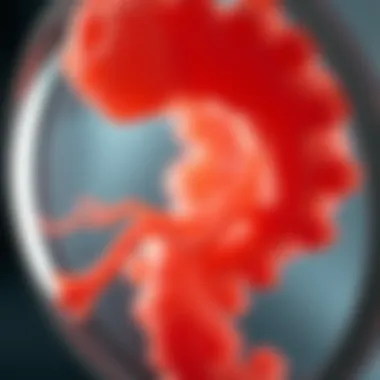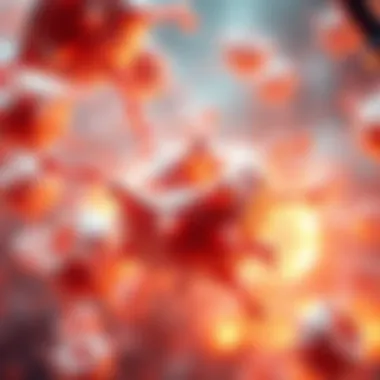The Evolution of Stem Cell Research Through History


Intro
The journey of stem cell research is as complex and varied as the cells themselves. It weaves through ancient philosophies, groundbreaking discoveries, fierce ethical debates, and unparalleled advancements in modern medicine. To truly grasp the significance of stem cells, one must start from the very beginning, where the curtain rises with early observations about embryonic development.
Stem cells, the building blocks of life, exhibit a remarkable capacity to evolve into various cell types, making them invaluable for scientific inquiry and therapeutic applications. This exploration will unfold historical milestones, pivotal researchers, and the implications of stem cell advances on medicine today. It's important for students, researchers, educators, and professionals alike to appreciate how these seemingly simple cells hold the key to regenerating tissues, curing diseases, and possibly even extending human life itself.
Prolusion to Stem Cells
Stem cells represent a fascinating frontier in biological science. They are unique in their ability to renew themselves through cell division and develop into various types of cells in the body. Understanding stem cells not only sheds light on fundamental biological processes but also opens the door to innovative therapies that could change how we treat diseases.
Definition and Types of Stem Cells
The term "stem cell" encompasses a broad range of cells with varying capabilities. At their core, stem cells are unspecialized cells that can differentiate into specialized cell types. There are primarily two categories of stem cells: embryonic stem cells and adult stem cells.
- Embryonic stem cells are derived from the early blastocyst stage of an embryo, around five days post-fertilization. These cells can give rise to nearly any cell type in the body, which makes them particularly valuable for regenerative medicine.
- Adult stem cells, on the other hand, are found in various tissues throughout the body. They serve a more specific purpose, typically involved in the repair and maintenance of the tissue in which they are found. An example includes hematopoietic stem cells in the bone marrow, which generate blood cells.
Additionally, there's a burgeoning area of research into induced pluripotent stem cells (iPSCs). This innovative technique involves reprogramming specific adult cells to exhibit pluripotency, thereby acquiring the ability to differentiate like embryonic stem cells. This offers a method to sidestep some ethical concerns surrounding embryonic stem cells while retaining significant research possibilities.
Significance in Biological Science
The importance of stem cells extends far beyond their definition. They are pivotal to our comprehension of developmental biology, tissue regeneration, and even cancer. Here are a few key points elaborating their significance:
- Understanding Development: Stem cells provide crucial insights into the early stages of development that lead to complex multicellular organisms. By studying these cells, researchers can unravel the process of differentiation—how a stem cell morphs into various specialized cells.
- Regenerative Medicine: The potential applications of stem cells in regenerative medicine are vast. They offer the possibility of repairing or replacing damaged tissues and organs, thus holding a promise for treating conditions like diabetes, heart disease, and spinal cord injuries.
- Disease Modeling: By creating specific cell types from stem cells, scientists can model various diseases in the lab. This helps in understanding disease mechanisms and testing potential therapies before they reach clinical trials.
"Stem cells are the key to understanding the complex interplay between genetic and environmental factors in human health."
In summary, stem cells stand as a linchpin in bridging biological research and practical applications in medicine. Their unique properties fuel ongoing investigations, potentially revolutionizing treatments and how we understand life itself. As this article unfolds, it will detail the evolution of stem cell research, the landmark discoveries, and the future directions that await us.
Early Concepts of Cell Differentiation
Cell differentiation is a pivotal concept in biology, one that sets the stage for understanding stem cells and their complexities. This phase in developmental biology is essential as it introduces the idea that a single zygote can develop into a myriad of specialized cells. Recognizing this enables scientists to comprehend how stem cells, which can differentiate into various cell types, function as the foundation for life's diversity.
Cell differentiation opens the door to various disciplines, providing insights into genetics, molecular biology, and regenerative medicine. The understanding of how cells transform from a general state to specific functions has profound implications, ranging from insights into genetic disorders to advancements in therapeutic strategies for treating degenerative diseases.
Simply put, understanding how cells differentiate equips researchers with the knowledge to manipulate these processes, paving the way for remarkable medical breakthroughs.
Foundational Theories in Developmental Biology
The theories surrounding developmental biology laid the groundwork for our current understanding of cellular differentiation. One of the most significant contributors to this discourse was the German embryologist Ernst Haeckel, who introduced the concept of the
Pioneering Research in Stem Cell Biology
Pioneering research in stem cell biology serves as the backbone of our understanding of cellular differentiation and regeneration. This field is not just an academic curiosity but a transformative force in medicine and biology. It lays the groundwork for exploring how we can harness the potential of stem cells in therapeutic settings. The implications of these studies extend beyond mere scientific inquiry; they carry the promise of reshaping treatments for degenerative diseases, injuries, and many conditions previously deemed untreatable.
The beauty of stem cell research lies in its intersectionality with various scientific disciplines, such as genetics, developmental biology, and regenerative medicine. Understanding stem cells allows scientists to dissect complex biological processes, from embryonic development to the repair of damaged tissues. During this phase, one can draw connections between foundational theories and emerging methodologies, showcasing how each builds upon the knowledge of the last.
Early Experiments and Findings
The journey of stem cell research began in earnest with several vital experiments that revealed the uniqueness and ability of these cells to transform into various tissue types. In the mid-20th century, research was primarily focused on hematopoietic stem cells, or HSCs, which are responsible for generating all types of blood cells. Early work by researchers such as Ernest McCulloch and James Till provided pivotal evidence that these stem cells reside in the bone marrow and can give rise to multiple blood cell lineages.
"The discovery of hematopoietic stem cells was akin to finding a needle in a haystack. It opened doors once thought closed in understanding the human body and its repair mechanisms."
Their experiments, often involving radiation to destroy blood cells in mice and subsequent transplantation of bone marrow, demonstrated the remarkable regenerative capacity of these cells. These initial findings laid the groundwork for later discovery of other stem cell types and fostered an environment conducive to exploring their wider applications.
Moreover, in the late 1960s and early 1970s, researchers demonstrated that stem cells could proliferate indefinitely in vitro while retaining their pluripotent characteristics. What this means is that, given the right conditions, they could generate specialized cells for various tissues. These advances were pivotal; they provided not only experimental techniques but also the philosophical frameworks that stimulated further inquiry into stem cell biology.
Culturing Stem Cells: Techniques and Advances
The culturing of stem cells represents a significant leap in research methodologies, effectively helping to bridge the gap between basic biology and clinical application. One of the most notable techniques is the use of feeder layers, which are necessary to support the growth and maintenance of stem cells in culture. Initially developed from mouse embryonic fibroblasts, these cultures allowed researchers to maintain pluripotency for extended periods.
By the 1980s, scientists had begun improving these methodologies, paving the way for more refined techniques such as the use of serum-free media and defined growth factors. Such advances not only improved the yields and viability of stem cell populations but also reduced the risk of contamination and variability in experimental outcomes.
Furthermore, with the advent of techniques such as induced pluripotent stem (iPS) cell technology in the late 2000s, it became clear that somatic cells could be reprogrammed back into a pluripotent state. This discovery was groundbreaking as it bypassed the ethical concerns associated with embryonic stem cells and opened new avenues for regenerative medicine without the moral implications traditionally tied to stem cell research.
The exploration of these techniques is a constantly evolving narrative. The enhancements in culturing methods have significant implications for drug discovery, disease modeling, and potential therapeutic applications. As we look to the future of stem cell research, ongoing efforts aim to refine these techniques further and explore new horizons, keeping an eye on engineering customized tissues for transplantation.
In summary, the pioneering research in stem cell biology has unveiled a universe of possibilities, setting the stage for future innovations and breakthroughs that might have once seemed the stuff of science fiction. Understanding the past empowers us to navigate the future of regenerative medicine and therapeutic interventions with insight and responsibility.


The Emergence of Adult Stem Cells
The discovery and understanding of adult stem cells have played a pivotal role in advancing our grasp of human biology and therapeutic possibilities. Unlike embryonic stem cells, which are derived from early-stage embryos, adult stem cells reside in various tissues throughout the body. Their primary function is to maintain and repair the tissue in which they are found. As the scientific community has come to appreciate their unique capabilities, the importance of these cells has garnered more attention, particularly regarding their potential applications in regenerative medicine.
Identification of Adult Stem Cell Types
Identifying different types of adult stem cells is crucial for harnessing their therapeutic power. Research has highlighted several key categories:
- Hematopoietic Stem Cells (HSCs): Found primarily in the bone marrow, these cells give rise to all blood cells, making them essential for treatments of blood-related disorders and cancers.
- Mesenchymal Stem Cells (MSCs): These cells, located in various tissues such as bone marrow, adipose tissue, and dental pulp, can differentiate into bone, cartilage, and fat cells. Their immunomodulatory properties make them promising candidates for treating injuries and degenerative diseases.
- Neural Stem Cells (NSCs): Present in the brain and spinal cord, NSCs are responsible for generating neurons and glial cells. They offer insight into potential treatments for neurological disorders such as Parkinson's disease.
- Epicardial Stem Cells: These reside in the heart and are potentially key to heart regeneration, especially after myocardial infarctions.
The variety among adult stem cells exemplifies the potential for tailoring therapies to specific conditions and patient needs.
Clinical Implications and Applications
The clinical implications of adult stem cells are broad and highly impactful. Here are notable applications:
- Regenerative Medicine: Adult stem cells are at the forefront of developing therapies for various diseases. For instance, HSC transplants are a well-established treatment for leukemia and other blood disorders.
- Orthopedic Treatments: MSCs are increasingly used in orthopedics to repair tissue injuries and facilitate healing, particularly in bone and cartilage. Their ability to promote regeneration has led to innovations in treating osteoarthritis and other degenerative conditions.
- Graft-Versus-Host Disease (GVHD): This complication can arise after HSC transplants. Understanding adult stem cell dynamics has improved management strategies and treatment outcomes for patients.
- Cardiovascular Treatments: Research into epicardial stem cells holds promise for heart disease. Delivering these cells to damaged heart tissue could potentially regenerate heart muscle.
The unique properties of adult stem cells pave the way for personalized medicine approaches; as scientists continue to explore their potential, the horizon for curing or alleviating debilitating conditions is inching closer. As the field progresses, a deeper understanding of adult stem cells could open doors previously thought locked tight, transforming healthcare and patient livelihoods in the process.
For more information about stem cells, you can check credible sources like Wikipedia and Britannica.
Breakthroughs in Embryonic Stem Cell Research
Embryonic stem cell research has been at the forefront of scientific exploration in recent decades. The significance of this field is rooted in its potential to revolutionize medical treatment and understanding of human development. Embryonic stem cells, derived from early-stage embryos, have the remarkable ability to differentiate into virtually any cell type in the body. This characteristic not only makes them invaluable for regenerative medicine but also helps illuminate the complexities of cellular behavior and development.
Isolation of Embryonic Stem Cells
The isolation of embryonic stem cells marked a pivotal step in developmental biology. In the early 21st century, researchers successfully extracted these cells from human embryos, leading to a breakthrough that had been long-sought. This process typically involves the following:
- Embryo Creation: Fertilized eggs are developed into blastocysts, usually at the five to six-day mark.
- Cell Extraction: The inner cell mass of the blastocyst is carefully removed, allowing the stem cells to be cultured.
- Culturing: The extracted cells are nurtured in a specific environment that promotes their growth and self-renewal.
The significance of this achievement cannot be understated. It opened doors to a wealth of research opportunities, including the possibility of growing tissues for transplantation and studying disease processes. The availability of human embryonic stem cells has profoundly impacted our understanding of diseases like diabetes, Parkinson's, and various degenerative conditions.
"With this newfound ability to isolate and culture embryonic stem cells, we stand at the brink of breakthroughs that may redefine treatment paradigms across multiple medical fields."
Controversies and Ethical Debates
While the excitement of such advancements is palpable, the journey of embryonic stem cell research has not been without controversy. Central to the ethical debates surrounding this research is the moral status of the embryos from which the cells are derived. Some view the embryos as potential human beings, leading to passionate arguments against their use in research, invoking concerns about the sanctity of life.
Key considerations in these ethical debates include:
- Moral Status of Embryos: Differing viewpoints regarding when life begins influence opinions on the acceptability of embryo research.
- Potential Benefits vs. Ethical Costs: Proponents argue that the potential benefits for society, such as treating debilitating diseases, should outweigh ethical concerns.
- Regulatory Guidelines: Different countries have developed varied regulatory frameworks to govern the use of embryonic stem cells, reflecting the polarized views on the matter.
The clash between scientific potential and ethical responsibility continues to stimulate discussions amongst scientists, ethicists, and the public. Balancing innovation with ethical considerations remains crucial as this field progresses. The future of embryonic stem cell research hinges not only on scientific breakthroughs but also on societal acceptance of the ethical landscape that shapes it.
Stem Cells in Regenerative Medicine
Stem cells hold a pivotal role in the realm of regenerative medicine, acting as a beacon of hope for conditions that were once deemed untreatable. Their unique ability to develop into various specialized cell types makes them a powerful tool in both understanding and combating diseases. Regenerative medicine aims to repair or replace damaged tissues and organs, significantly improving the quality of life for many individuals. By unleashing the potential of stem cells, researchers are navigating the intricate pathways of human biology and finding innovative solutions to health issues.
The benefits of stem cell applications in regenerative medicine are extensive. They include:
- Tissue Repair: Stem cells can be induced to generate healthy cells that replace damaged or diseased ones. This is particularly promising for conditions such as heart disease, where cardiac tissue can be regenerated.
- Enhanced Understanding of Disease: By studying stem cells, scientists gain insights into the mechanisms behind various illnesses, allowing for earlier detection and more effective treatment strategies.
- Personalized Medicine: Stem cells open the door to tailoring treatments to individual patients. The potential to create patient-specific cells can lead to customized therapies, minimizing the risk of rejection or adverse reactions.
Application in Tissue Engineering
Tissue engineering represents a significant advancement in regenerative medicine, with stem cells serving as the cornerstone of this field. Techniques often involve the combination of scaffolding materials that support cell growth and differentiation, paired with stem cells to create functional tissue constructs. For instance, in the area of skin regeneration, researchers utilize stem cells to develop skin grafts for burn victims and those with skin diseases. This process addresses not just the aesthetic but the vital functional aspects of skin integrity.
In practical scenarios, research has shown that scaffolds seeded with stem cells heal wounds faster than traditional methods. This has led to breakthroughs in managing conditions like diabetic ulcers, where healing can be remarkably slow. The integration of stem cells into biomaterials can produce living tissues that mimic natural biology more closely, enhancing the effectiveness of treatments.
Moreover, the versatility of stem cells allows for a broad array of tissues to be engineered, including:
- Cartilage: Useful in repairing joints, particularly in conditions like osteoarthritis.
- Neurons: Promising strides are being made towards treating neurodegenerative diseases by regenerating nerve tissues.
Potential in Treating Degenerative Diseases
Degenerative diseases are a significant burden on healthcare systems and affect millions across the globe, leading to a gradual decline in health and well-being. Stem cells present a remarkable opportunity to halt or reverse the progression of these conditions. By replacing lost or damaged cells, stem cells have the potential to restore normal function in diseased tissues.


Research is increasingly focusing on degenerative conditions such as:
- Alzheimer's Disease: Experimental therapies that utilize neural stem cells aim to replenish lost neurons and restore cognitive function.
- Parkinson's Disease: Stem cell treatments seek to replace dopaminergic neurons, which are crucial for movement control, addressing both symptoms and underlying pathology.
- Spinal Cord Injuries: Strategies involving stem cells may promote repair and functional recovery after traumatic spinal cord injuries.
The promise of stem cells in treating degenerative diseases lies in their capacity to regenerate and repair, providing a new lease on life to many.
In summary, stem cells play an indispensable role in the advancement of regenerative medicine. Their ability to foster tissue repair and treat degenerative diseases presents an array of possibilities that could redefine our approach to health care. As research continues to unfold, the future looks bright for stem cell applications, making it an exciting time for both scientists and patients alike.
For more detailed insights into stem cells and their applications in medicine, consider visiting:
Current Techniques in Stem Cell Research
The field of stem cell research has undergone tremendous evolution, and the current techniques employed in this area are pivotal for advancing our understanding and application of stem cells. These techniques are not just about manipulating cells; they herald new possibilities in medicine, offering promising pathways for treating a variety of diseases. In this section, we delve into some of the recent innovations and methodologies that are shaping the contemporary landscape of stem cell research.
Recent Innovations and Methodologies
In the realm of stem cells, innovation is the name of the game. Various methodologies are employed to harness the unique properties of stem cells, each presenting its own set of advantages and intricacies. Here are a few noteworthy innovations:
- Induced Pluripotent Stem Cells (iPSCs)
iPSCs have revolutionized the field since their development. Created by reprogramming somatic cells, they can give rise to any cell type, similar to embryonic stem cells. This has opened doors for patient-specific therapies and drug testing. - Three-Dimensional Culturing
Traditional two-dimensional culturing methods limit the natural cell behaviour. Recent advancements include three-dimensional scaffolds, allowing cells to mimic their in vivo environment more closely. This enhances their survival, differentiation, and functional capabilities, providing crucial insights for therapeutic applications. - Organoids
Miniaturized and simplified versions of organs, called organoids, provide a powerful platform for studying organ-specific functions and diseases. These structures are generated from stem cells and can model everything from human development to disease pathology, proving invaluable for drug discovery and regenerative medicine. - Bioprinting
This technique allows researchers to print living cells in defined patterns to engineer tissues. The ability to produce complex tissue structures can lead to breakthroughs in transplantation and regenerative therapy.
By leveraging these innovative techniques, researchers can explore the functional mechanisms of stem cells more thoroughly, potentially translating these findings into clinical practice.
The Role of Gene Editing Tools
The landscape of stem cell research is also being transformed by gene editing technologies. Tools like CRISPR-Cas9 have become household names within the scientific community. They enable precise modifications to the DNA of stem cells, facilitating a deeper understanding of gene functions and disease mechanisms.
Benefits of Gene Editing
- Targeted Modifications: Researchers can insert, delete, or alter genes with high precision. This has profound implications for studying the roles of specific genes in differentiation and disease.
- Disease Modelling: Utilizing gene-edited stem cells allows researchers to create models of genetic disorders, offering insights into their progression and potential treatments.
- Therapeutic Prospects: Gene editing could pave the way for correcting genetic defects in stem cells, leading to tailored therapies for previously untreatable conditions.
By integrating these gene editing tools into stem cell research, we gain not just enhanced capabilities for investigation, but also a strong pathway towards personalized medicine.
"Understanding stem cells through cutting-edge techniques represents not only a scientific advancement but a critical leap towards addressing some of the most pressing health challenges of our time."
In summary, current techniques in stem cell research epitomize the fusion of innovative methodologies and precision tools that together enhance our understanding and application of stem cells in medicine. These advances bear great significance for the future of regenerative therapies, offering glimmers of hope for patients in need.
For further reading, you can explore resources at Wikipedia, Britannica, and dedicated scientific journals that specialize in regenerative medicine.
Global Regulatory Frameworks and Policies
The realm of stem cell research is not merely an area of scientific inquiry; it's a landscape intricately woven with regulatory threads that ensure ethical boundaries and clinical efficacy. The global regulatory frameworks shaping stem cell science anchor the progression of research and applications in this field, trying to strike a balance between innovation and safety.
Understanding the regulations is pivotal because they dictate how and where stem cell research can occur, the types of stem cells that can be utilized, and the protocols that must be adhered to when conducting clinical trials. These frameworks vary across countries, reflecting cultural values, ethical considerations, and safety protocols pertinent to each region. As a result, researchers must navigate a complex labyrinth of rules designed not just to regulate, but to protect individuals and society at large.
Variations in Stem Cell Legislation
Stem cell legislation takes on diverse forms around the world, influenced by historical, ethical, and scientific contexts unique to each country. For instance:
- United States: The regulation largely hinges on the restrictions imposed by the National Institutes of Health (NIH) and state-level laws. Federal funding is often limited to certain lines of embryonic stem cells, fostering an environment where private funding may flourish but public investment remains cautious.
- Europe: Many European nations have rigorous legislation emphasizing the ethical sourcing of stem cells. For example, the European Union requires compliance with strict standards for safety and quality, leading to a slower but arguably more ethical progression in stem cell applications.
- Asia: Countries like Japan have embraced more lenient policies to promote innovation while ensuring oversight. The combination of policies designed to facilitate advancement reflects an understanding of both potential risks and rewards in this dynamic field.
Some key legislative contents to consider include:
- Approval processes for new therapies
- Regulations around consent for stem cell donation
- Oversight of clinical trials to ensure they meet ethical standards
- Guidelines for advertising or promoting stem cell therapies
The landscape of stem cell legislation is not static; it's a constantly evolving narrative influenced by scientific discoveries and societal values. Researchers are often found advocating for clearer and more consistent regulations that can foster innovation while addressing ethical concerns.
International Collaborations and Agreements
As scientists worldwide seek to unlock the potential of stem cells for therapeutic uses, international collaboration has emerged as a cornerstone of successful research initiatives. These collaborations are critical, not just for sharing knowledge, but also for harmonizing regulatory approaches across different jurisdictions.
International agreements enhance the capacity for research by:
- Facilitating Cross-Border Research: Collaborative projects that cross borders allow for combined expertise, resources, and methodologies. This synergy can lead to breakthroughs that might be unattainable working in isolated national frameworks.
- Setting Common Ethical Standards: Organizations like the International Society for Stem Cell Research (ISSCR) work towards establishing globally recognized ethical guidelines. Such initiatives can help standardize practices and ensure that research is conducted responsibly, regardless of geographical boundaries.
- Promoting Data Sharing and Transparency: Collaborative platforms often enhance data sharing among researchers, which accelerates the pace of discovery and minimizes duplication of efforts. Transparency in this field is crucial as researchers seek to build trust among stakeholders including the public, policymakers, and funding bodies.
This collaborative spirit fosters a sense of communal responsibility, pushing boundaries while adhering to ethical norms. It reminds us that while the journey into the mechanisms of stem cells is scientific, it also demands a socially conscious approach. Without a global regulatory framework, the potential to harness the full promise of stem cell science would be significantly impaired.


"In science, one often stands on the shoulders of giants. Through collaboration, we ensure that those giants are no longer solitary figures, but part of a global effort to improve lives."
For more information, consider visiting:
- National Institutes of Health (NIH)
- European Medicines Agency (EMA)
- International Society for Stem Cell Research (ISSCR)
Ethical Considerations in Stem Cell Research
The discussion surrounding ethical considerations in stem cell research is paramount, given the potential implications for future medical advancements and societal values. Stem cell research offers hope for treating a myriad of diseases, yet it raises pressing questions about the moral and ethical frameworks guiding scientific exploration. To navigate this complex landscape, several vital elements must be examined.
Balancing Innovation with Ethical Responsibility
When it comes to progress in science, there exists a fine line between innovation and ethics. On one side, the promise of stem cells to regenerate damaged tissues or organs contributes significantly to the field of regenerative medicine. For instance, conditions like Parkinson's disease, spinal cord injuries, and heart diseases could find potential treatments through these cellular therapies. On the other hand, it is crucial to approach these advancements with a thoughtful mindset, prioritizing ethical responsibility.
One avenue of consideration is the sourcing of stem cells. Using embryonic stem cells often leads to ethical dilemmas, as it can involve the destruction of embryos. In contrast, adult stem cells and induced pluripotent stem cells (iPSCs) present alternative solutions that typically sidestep these moral issues. However, the challenge lies in adequately communicating these differences to the public and regulators, ensuring transparency and fostering acceptable methods based on informed consent.
Public Perception and Ethical Dialogues
Another essential aspect to explore concerns public perception of stem cell research. Historically, public feelings have swayed the direction of funding, legislative frameworks, and ultimately the pace of scientific discovery. You know what they say: you can't please everyone. For some, the potential for medical breakthroughs overshadows the ethical quandaries. Others, however, feel deeply uncomfortable with any research that compromises human life, however slowly it unfolds. This contrast can lead to heated ethical dialogues within communities, impacting policy formulations significantly.
The role of education in shaping these discussions is vital. Educational campaigns that clearly outline the types of stem cells, their uses, and the ethical implications involved can help demystify the complexities tied to stem cell research. Moreover, engaging the public in these conversations allows researchers and biotechnology companies to cultivate trust and promote a mutually beneficial relationship.
It is through ongoing dialogue and education that society can bridge the gap between groundbreaking scientific potential and ethical accountability. As we dive deeper into stem cell research, finding a balance will not only enhance scientific endeavors but also affirm a commitment to a just and ethical society.
"Ethics in science serves as the institutional backbone, guiding the quest for knowledge while ensuring human dignity is upheld."
In wrapping up this discussion, it is clear that navigating the ethical waters of stem cell research requires careful consideration of various facets, including public perception, communication strategies, and a focus on responsible innovation. Promoting ethical dialogue is essential for sustained progress, allowing society to proceed on a path that values both scientific exploration and moral integrity.
Future Directions in Stem Cell Research
The domain of stem cell research is a rapidly evolving landscape, where each step forward brings both excitement and apprehension. Significant strides have been made in recent years, yet the horizon is filled with potential breakthroughs waiting to be unearthed. The importance of discussing future directions in this field cannot be overstated, as these developments promise to have substantial impacts on regenerative medicine, disease understanding, and therapeutic applications.
Emerging Trends and Technologies
As the scientific community delves deeper into the realm of stem cells, several emerging trends are coming to the forefront that may redefine our understanding of cellular biology and medicine. Notably:
- Induced Pluripotent Stem Cells (iPSCs): The innovation of iPSCs has overturned many traditional notions about stem cells. They allow scientists to reprogram somatic cells into a pluripotent state, making them capable of developing into any cell type in the body. This advancement brings significant advantages in personalized medicine, as cells can be derived from patients for disease modeling and potential therapies.
- Organoids and 3D Culturing: The development of organoids, which are miniature organs grown from stem cells, has opened new avenues for studying complex biological processes. These in vitro models provide a platform to understand tissue development and the pathology of diseases from a more realistic perspective.
- CRISPR and Gene Editing: The advent of CRISPR technology offers precise editing capabilities at the genomic level. This tool enhances our ability to correct genetic defects in stem cells, potentially curing hereditary diseases before they manifest. By using CRISPR in stem cell research, scientists can also better study gene functions and disease mechanisms.
While these technologies signal the potential for revolutionary advancements, they also beg the question: What are the ethical implications associated with these innovations? Research must navigate these waters carefully to avoid unintended consequences.
Anticipated Challenges and Opportunities
With each emerging trend, a set of challenges invariably rises to meet them. In the domain of stem cell research, it’s essential to consider both the obstacles and the opportunities for growth. Some challenges include:
- Regulatory Hurdles: Navigating the complex landscape of regulations can slow down research progress. Each country may have different guidelines affecting how stem cells can be researched or applied in clinical settings. Striking a balance between innovation and safety is crucial.
- Scientific Limitations: Despite the promise of stem cells, there are still many unknowns. Not all stem cells behave as desired in therapeutic settings. There’s a chance that not every approach will yield the anticipated outcomes, necessitating ongoing experimentation and validation.
However, with challenges come significant opportunities:
- Growth of Collaboration: Increased collaboration among researchers, governments, and industries can accelerate progress, resulting in a shared pool of knowledge and resources.
- Innovation in Treatments: As technology progresses, novel treatment options for conditions previously deemed untreatable may emerge, transforming patient outcomes in profound ways.
"The future of stem cell research is not just about what we can achieve, but how we ethically and responsibly navigate the complex implications of those achievements."
Closure
The narrative of stem cell science has unfolded over centuries, shaped by groundbreaking research and relentless exploration. Understanding the historical milestones proves essential not merely as a reflection on past achievements but as a foundation for future explorations in the field. The journey through time emphasizes key elements that have played a role in the remarkable advancements witnessed today.
Recap of Historical Developments
The history of stem cells is rife with significant milestones that, when viewed collectively, offer a rich tapestry illustrating the evolution of scientific thought. From the early theories of cell differentiation laid out by pioneers in the field of developmental biology to the controversial debates surrounding embryonic stem cells, each historical thread contributes to our current understanding of this critical area of research.
For instance, in the mid-20th century, researchers such as Ernest McCulloch and James Till made staggering contributions, identifying the existence of stem cells in bone marrow. Their pioneering studies marked a fundamental shift in how scientists perceived the potential of these unique cells.
Moreover, the emergence of adult stem cells and the discovery of embryonic stem cells in the late 1990s opened new doors for regenerative medicine. These developments sparked an array of clinical applications, leading to therapies that harness the body's intrinsic repair mechanisms. Ethical debates surrounding such innovations underscore the significance of balancing scientific progress with moral responsibility.
Ultimately, these historical developments underscore the relentless pursuit of knowledge. The interplay between scientific discovery and ethical considerations remains a central theme within the field, guiding current research and informing future endeavors.
The Ongoing Journey of Stem Cell Science
Today, the field of stem cell research continues to advance at a breakneck pace. Ongoing studies delve into the nuances of gene editing technologies and innovative culturing methods, expanding our understanding of stem cell behavior and applications. As we look ahead, it is imperative to acknowledge both the challenges posed by scientific discovery and the opportunities they present for transformative breakthroughs in medicine.
The ongoing journey in stem cell science highlights the overarching need to stay vigilant regarding ethical considerations while fostering an environment conducive to innovation. The ever-evolving landscape of technology and regulatory frameworks will significantly influence the trajectory of stem cell applications in various medical fields.
It is the commitment to rigorous research and ethical integrity that will ultimately shape the future of stem cell science, ensuring advancements benefit society at large.
In summary, the summary encapsulates not just a historical account but also a vision for what lies ahead. As researchers, educators, and policymakers map the route for stem cell exploration, they must do so with a sense of responsibility to humanity and the ecosystems that support scientific inquiry. The legacy of stem cell research is only just beginning, and the next chapters promise even greater discoveries.







